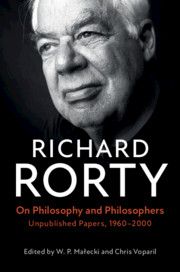Book contents
- On Philosophy and Philosophers
- On Philosophy and Philosophers
- Copyright page
- Contents
- Acknowledgments
- Note on Sources
- Introduction: Rorty as a Critical Philosopher
- I Early Papers
- II Later Papers
- 9 Philosophy as Epistemology: Reply to Hacking and Kim
- 10 Naturalized Epistemology and Norms: Replies to Goldman and Fodor
- 11 The Objectivity of Values
- 12 What Is Dead in Plato
- 13 The Current State of Philosophy in the United States
- 14 Brandom’s Conversationalism: Davidson and Making It Explicit
- 15 Bald Naturalism and McDowell’s Hylomorphism
- 16 Reductionist vs. Neo-Wittgensteinian Semantics
- 17 Remarks on Nishida and Nishitani
- Index of Names
16 - Reductionist vs. Neo-Wittgensteinian Semantics
from II - Later Papers
Published online by Cambridge University Press: 10 October 2020
- On Philosophy and Philosophers
- On Philosophy and Philosophers
- Copyright page
- Contents
- Acknowledgments
- Note on Sources
- Introduction: Rorty as a Critical Philosopher
- I Early Papers
- II Later Papers
- 9 Philosophy as Epistemology: Reply to Hacking and Kim
- 10 Naturalized Epistemology and Norms: Replies to Goldman and Fodor
- 11 The Objectivity of Values
- 12 What Is Dead in Plato
- 13 The Current State of Philosophy in the United States
- 14 Brandom’s Conversationalism: Davidson and Making It Explicit
- 15 Bald Naturalism and McDowell’s Hylomorphism
- 16 Reductionist vs. Neo-Wittgensteinian Semantics
- 17 Remarks on Nishida and Nishitani
- Index of Names
Summary
In “Reductionist vs. Neo-Wittgensteinian Semantics,” Rorty does two things: proposes a distinction between reductionist and neo-Wittgensteinian semantics and suggests we see Robert Brandom’s philosophy as contributing to the latter. By “reductionist semantics,” Rorty means a semantics that aims at purifying language by finding equivalent and more perspicuous expressions for expressions we currently use. “Neo-Wittgensteinian semantics” entails a semantics for which such a program does not make any sense because it assumes any expression has a perfectly respectable meaning merely by virtue of having a use. It is “neo-Wittgensteinian” because the view of meaning as use originates in Philosophical Investigations, and “neo-Wittgensteinian” because it relies on how that view was later developed by the likes of Quine, Sellars, Davidson, and Brandom. Having explained why Brandom should be so classified, Rorty then proceeds to discuss Brandom’s most valuable and original contribution to this type of semantics: Brandom’s account, in Making It Explicit, of the constraints on the use of marks and noises that make it possible for us to be said to be reasoning rather than simply sounding off in habitual, accepted ways.
- Type
- Chapter
- Information
- On Philosophy and PhilosophersUnpublished Papers, 1960–2000, pp. 226 - 239Publisher: Cambridge University PressPrint publication year: 2020



